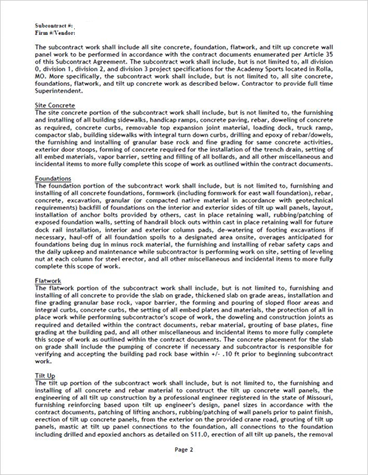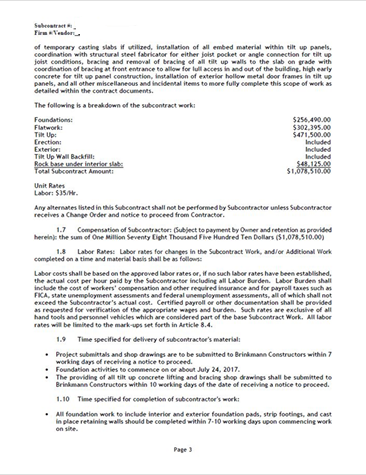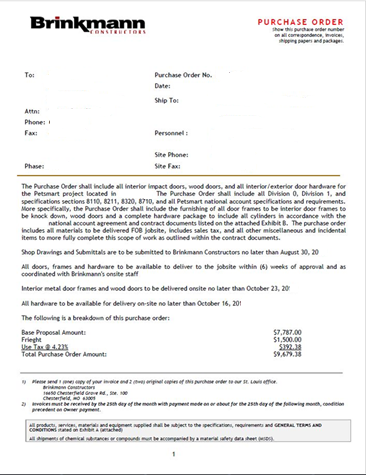Subcontracts-POs
|
|
| CONTRACTS 101 |
What is a contract?
Brinkmann Subcontract
Sample Brinkmann Subcontract
Sample Brinkmann Purchase Order
|
| WHY HAVE A CONTRACT |
|
| CONTRACT INTERPRETATION BASICS |
|
| BRINKMANN SUBCONTRACT STANDARDS |
Compliance/Returned Executed Subcontract
|
| UNDERSTAND IMPORTANT SECTIONS OF THE CONTRACT / PURCHASE ORDER |
Sections of the Contract
Materials
Equipment
Schedule
Meetings
Taxes
Temporary Power
Temporary Power and Safety
Layout and Coordination
Coordination
Safety
Clean Up
|
| BRINKMANN SUBCONTRACT |
|
Court/Litigation
|
| NEGOTIATING CONTRACTS - |
Prime Contract Clauses
Prime Contract: IndemnityBroad Form Indemnity Contractor shall indemnify, defend and save harmless the Owner, and its officers, directors, employees and agents, from and against all liability, loss, cost or expense (including attorney’s fees) by reason of liability imposed upon the Owner, arising out of or related to Contractor’s Work, whether caused by or contributed to by the Owner or any other party indemnified herein. Intermediate Form The Contractor shall indemnify and hold harmless the Owner for all damages, losses, or claims that arise as a result, in whole or in part, from the negligence, or error, omissions, or failure to perform by the Contractor, its employees, its agents, or its Subcontractors. Limited or Narrow Form § 3.18 INDEMNIFICATION § 3.18.1 To the fullest extent permitted by law the Contractor shall indemnify and hold harmless the Owner, Architect, Architect’s consultants, and agents and employees of any of them from and against claims, damages, losses and expenses, including but not limited to attorneys’ fees, arising out of or resulting from performance of the Work, provided that such claim, damage, loss or expense is attributable to bodily injury, sickness, disease or death, or to injury to or destruction of tangible property (other than the Work itself), but only to the extent caused by the negligent acts or omissions of the Contractor, a Subcontractor, anyone directly or indirectly employed by them or anyone for whose acts they may be liable, regardless of whether or not such claim, damage, loss or expense is caused in part by a party indemnified hereunder. (AIA – A201) How broad is the clause?
Are you obligated to indemnify others for their own actions? Are the indemnification obligations mutual? Mutual Indemnity - ConsensusDOCS 200: 10.1.1 To the fullest extent permitted by law, the Contractor shall indemnify and hold harmless the Owner, the Owner’s officers, directors, members, consultants, agents and employees, the Architect/Engineer and Others (the Indemnitees) . . . 10.1.2 To the fullest extent permitted by law, the Owner shall indemnify and hold harmless the Contractor; its officers, directors, members, consultants, agents, and employees, Subcontractors or anyone employed directly or indirectly by any of them or anyone for whose acts any of them may be liable . . . Prime Contract: Mechanic’s LiensMechanic’s Lien Indemnity – Typical Clause § 15.5.4 Provided the Owner has fulfilled its payment obligations under the Contract Documents, the Contractor shall defend and indemnify the Owner from all loss, liability, damage or expense, including reasonable attorney’s fees and litigation expenses, arising out of any lien claim or other claim for payment by any Subcontractor or supplier of any tier. Upon receipt of notice of a lien claim or other claim for payment, the Owner shall notify the Contractor. If approved by the applicable court, when required, the Contractor may substitute a surety bond for the property against which the lien or other claim for payment has been asserted. Mechanic’s Lien Indemnity – Issues
Mechanic’s Lien Indemnity – Alternative Language § 15.5.4 Provided the Owner has made full payment to Contractor for the the Work that is the subject of the lien or claim, the Contractor shall defend and indemnify the Owner from all loss, liability, damage or expense, including reasonable attorney’s fees and litigation expenses, arising out of any lien claim or other claim for payment by any Subcontractor or supplier of any tier. Upon receipt of notice of a lien claim or other claim for payment, the Owner shall notify the Contractor. If approved by the applicable court, when required, the Contractor may substitute a surety bond for the property against which the lien or other claim for payment has been asserted. Contractor shall be allowed to contest the lien or claim so long as it has provided substitute security in the amount of 150% of the value of the lien or claim. Disbursing Agreement – Lien Indemnity Indemnitor will hold harmless, protect and indemnify Title Company from and against any and all liabilities, losses, damages, expenses and charges including attorney’s fees and expenses of litigation, which Title Company may sustain under any policy of insurance respecting the land resulting directly from any mechanic’s lien, or claim thereof, or which Title Company may sustain in the enforcement of this Agreement. Indemnitor’s obligations to hold harmless, protect and indemnify Title Company shall only apply to the extent that the Indemnitor has been paid for the work that is the subject of the mechanic’s lien or claim. Advanced Lien Waiver / No Lien Clause As a condition of Owner entering into this Contract with Contractor, Contractor agrees that it shall not assert rights to or claim a lien, or encumbrance of any type or kind, including any mechanic’s lien on any portion of the land, buildings, equipment, fixtures, or materials that constitute or form a part of the Project. Advanced Lien Waiver – Issues
Lien Subordination – Typical Clause Contractor hereby subordinates any mechanics’ and materialmen’s liens or other claims or encumbrances that may be brought by Contractor against any or all of the Work, the Site or the Project to any liens granted in favor of Lender, whether such lien in favor of Lender is created, attached or perfected prior to or after any such liens, claims or encumbrances, and shall require its Subcontractors and Sub-subcontractors to similarly subordinate their lien, claim and encumbrance rights. Contractor agrees to comply with reasonable requests of Owner for supporting documentation required by Lender in connection with such subordination, including any necessary lien subordination agreements by Contractor. Lien Subordination – Issues
Prime Contract: Notice Provisions
Prime Contract: Differing Site Conditions
TYPE 1 and TYPE 2 CLAIMS § 3.7.4 Concealed or Unknown Conditions. If the Contractor encounters conditions at the site that are (1) subsurface or otherwise concealed physical conditions that differ materially from those indicated in the Contract Documents or (2) unknown physical conditions of an unusual nature, that differ materially from those ordinarily found to exist and generally recognized as inherent in construction activities of the character provided for in the Contract Documents, * * * (From AIA A201-2017) Notice of the Potential Claim Is Important § 3.7.4 Concealed or Unknown Conditions. * * *, the Contractor shall promptly provide notice to the Owner and the Architect before conditions are disturbed and in no event later than 14 days after first observance of the conditions. * * * (From AIA A201-2017 General Conditions) Prime Contract: No-Damage-For-DelaysTypical Clause § The Owner shall not be liable to the Contractor and/or any Subcontractor for claims or damages of any nature caused by or arising out of delays. The sole remedy against the Owner for delays shall be the allowance of additional time for completion of the Work, the amount of which shall be subject to the claims procedure set forth in the General Conditions.
Prime Contract: Liquidated Damages
Prime Contract: Waiver of Consequential Damages§ 15.1.6 CLAIMS FOR CONSEQUENTIAL DAMAGES The Contractor and Owner waive Claims against each other for consequential damages arising out of or relating to this Contract. This mutual waiver includes .1 damages incurred by the Owner for rental expenses, for losses of use, income, profit, financing, business and reputation, and for loss of management or employee productivity or of the services of such persons; and .2 damages incurred by the Contractor for principal office expenses including the compensation of personnel stationed there, for losses of financing, business and reputation, and for loss of profit except anticipated profit arising directly from the Work. This mutual waiver is applicable, without limitation, to all consequential damages due to either party’s termination in accordance with Article 14. Nothing contained in this Section 15.1.6 shall be deemed to preclude an award of liquidated damages, when applicable, in accordance with the requirements of the Contract Documents. (AIA A201-2017)
Prime Contract: TerminationTermination for Default
Termination for Convenience
§ 20.2 Termination by the Owner for Cause § 20.2.1 The Owner may terminate the Contract if the Contractor .1 repeatedly refuses or fails to supply enough properly skilled workers or proper materials; .2 fails to make payment to Subcontractors for materials or labor in accordance with the respective agreements between the Contractor and the Subcontractors; .3 repeatedly disregards applicable laws, statutes, ordinances, codes, rules and regulations, or lawful orders of a public authority; or .4 otherwise is guilty of substantial breach of a provision of the Contract Documents or .5 Termination For Convenience § 14.4.3 In case of such termination for the Owner’s convenience, the Owner shall pay the Contractor for Work properly executed; costs incurred by reason of the termination, including costs attributable to termination of Subcontracts; and the termination fee, if any, set forth in the Agreement. (AIA – A201 2017) Termination Issues
Prime Contract: Substantial Completion§ 9.8.1 Substantial Completion is the stage in the progress of the Work when the Work or designated portion thereof is sufficiently complete in accordance with the Contract Documents so that the Owner can occupy or utilize the Work for its intended use. (AIA A201-2017)
§ 9.8.1 The date of Substantial Completion of the Work (or designated portion thereof as may be hereafter agreed by Owner) is the date determined by Owner when the Work is sufficiently complete, in accordance with the Contract Documents, so that the Owner (or its tenants) can occupy or utilize the Work or such designated portion thereof for the use for which it is intended with all of the installations, parts and systems related thereto and required by the Work hereunder functional, accessible, operable and usable by the Owner for their intended usage. Such completion shall include, as applicable, all temporary certificates of occupancy or other permits of authorizations by governmental agencies having jurisdiction thereof, necessary to permit such usage. Notwithstanding the foregoing, Contractor shall obtain the final certificate of occupancy before any temporary certificate(s) of occupancy expire and shall be responsible for any costs to the Owner if the Owner is required to abandon any use or occupancy of the Project arising out of the expiration of a temporary certificate of occupancy. Only minor and incidental corrective work under Owner-approved punchlists and final cleaning (if required) beyond cleaning needed for the Owner's full use may remain for Final Completion. Forum Selection, Choice of Law, Attorneys’ Fees
Brinkmann Standard SubcontractPay-if-Paid 5.7 Contractor will use Owner funds to pay Subcontractor within ten (10) days after receipt and Contractor shall have no obligation to pay Subcontractor for the Subcontract Work, or any claims related thereto, unless and until Owner pays Contractor for the same. Contractor’s receipt of funds by payment from Owner shall be a condition precedent to Contractor’s obligation to pay Subcontractor. Subcontractor hereby acknowledges that it relies on the credit of Owner, not Contractor, for payment of Subcontract Work, and the parties agree that Subcontractor shall bear the risk of Owner’s nonpayment. Subcontract: Pay-If-Paid Compromise Language 5.12 Notwithstanding anything to the contrary in Article 5 of this Subcontract Agreement, if Owner is financially able to pay and Owner's refusal to pay Contractor is without fault of Subcontractor (or any sub-subcontractor or supplier to Subcontractor of any tier) and wholly the fault of Contractor or its other subcontractors or suppliers, then nothing in this Article 5 shall limit Subcontractor's right to receive payment or recover payment against Contractor or its surety. THIS LANGUAGE SHOULD ONLY BE USED AS A LAST RESORT. Subcontract: Indemnity10.1 To the fullest extent permitted by law, Subcontractor shall defend and indemnify Contractor and all others whom Contractor is obligated to defend and indemnify by the Contract Documents, (collectively “the indemnified parties”) from and against any and all suits or claims alleging damages, losses and expenses, including attorneys’ fees, attributable to injuries to persons or damage to property (including loss of use), arising out of or resulting from Subcontractor’s Work, including all suits and claims that arise during and after construction of the Project, except to the extent such suits or claims are caused by the negligence or fault of the party seeking indemnity under this Article or of any other party under the control of such party seeking indemnity. Subcontractor understands and agrees that this Article obligates Subcontractor to reimburse any of the indemnified parties for attorneys’ fees and costs incurred by any of them as a result of such suits or claims, except to the extent such fees and costs result from the negligence or fault of the party seeking indemnity under this Article or of any other party under the control of such party seeking indemnity. Subcontractor understands and agrees that this Article 10 also obligates Subcontractor to pay any and all attorneys’ fees and expenses incurred by any of the indemnified parties in connection with enforcing the obligations of this Article. 10.3 Subcontractor agrees to indemnify, defend and hold harmless Contractor, Owner, A/E or any surety on the Project from any and all real or spurious claims, demands, suits, damages, interest, litigation expenses, court costs, arbitration expenses, attorney’s fees, costs and expenses of whatsoever kind or nature, whether arising before or after completion of Subcontractor’s work hereunder, to the extent that Subcontractor, its sub-subcontractors, suppliers, invitees or others acting on Subcontractor’s behalf fail to fully perform any and all of the obligations of the Subcontract. Subcontract: Risk of LossIndemnity & Risk Of Loss: Sub Example Subcontract: No Damage For Delays6.4 No payment of any kind, for compensation, costs, expenses or for damages, or otherwise shall be made or owed by Contractor to Subcontractor because of any such delay even though Subcontractor’s extension of time request be granted, unless as a condition precedent thereto Owner pays Contractor compensation or damages because of such delay, and then, as and when Owner pays such compensation or damages to Contractor, Subcontractor shall receive from Contractor that share of such compensation or damages that can be agreed to or proven to have been directly attributable to such delay. Common Subcontractor Question: What if Brinkmann is the cause of the delay? Schedule & DelaySchedule & Delay: Sub Example Schedule & Delay: A Project Schedule must be agreed to by [SUB] before commencement of the work. Changes to the Project Schedule will not be valid and binding unless agreed to by [SUB]. If [SUB] is delayed at any time in the commencement or progress of the work, by any act, or neglect, or failure to respond, of the Contractor, or by any other subcontractor, or by changes ordered in the work; then the contract time, and cost, shall be adjusted accordingly. Any schedule accelerations that are requested or required, except due to the extent caused by [SUB], will be at an additional cost to Contractor.
|
| SUPPORT DOCUMENTS |
| Current List of Contracts |
RA





